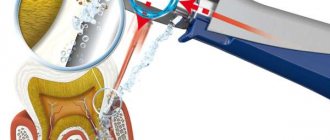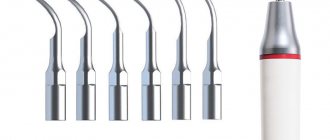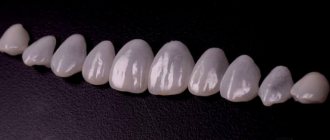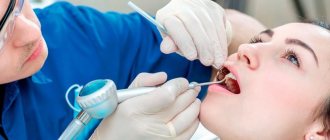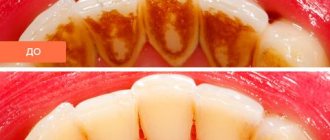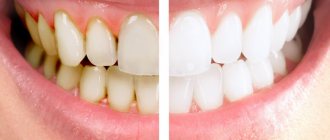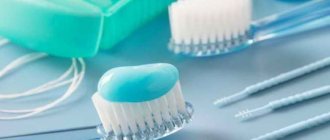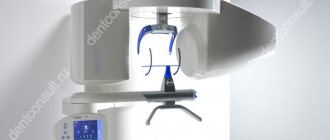Daily brushing and toothpaste does not guarantee that plaque will not accumulate, which is the main cause of tooth decay. There are several methods of professional hygiene, the most popular of which is ultrasonic teeth cleaning. Ultrasonic rays effectively destroy hard plaque without damaging the enamel. Today, experts advise ultrasonic cleaning to be carried out before any treatment or restoration, as well as as an independent procedure.
What is ultrasonic teeth cleaning
The main purpose of ultrasonic teeth cleaning is to remove hard deposits from the surface of tooth enamel. The so-called “tartar” is a mineralized plaque formed from decomposed food debris. But you shouldn’t think that stone can only occur in people who do not practice oral hygiene responsibly enough. It is impossible to remove all plaque with a regular brush, so the process of its mineralization occurs in absolutely all people. But, if a person smokes or drinks too much coffee or tea, then this stone becomes visually noticeable.
Ultrasonic cleaning is a painless and effective method. In addition, it is non-contact because the dentist's instrument (ultrasonic scaler) does not touch the teeth. This eliminates the possibility of scratches and other negative mechanical damaging effects. The scaler produces silent oscillations with a frequency of 16 to 45 thousand hertz. They are the ones who destroy mineralized deposits, crush them into tiny fragments, which are then washed off with sprayed water. The frequency level of the scaler is selected by the doctor depending on the area being treated.
Important: the procedure should only be performed by a qualified specialist using professional equipment in a dental clinic. Otherwise, there is a risk of harm to the health of teeth, gums and the body as a whole.
Advantages
Ultrasonic cleaning guarantees the following effect:
- removal of plaque and tartar,
- smooth and clean teeth,
- fresh breath,
- light whitening effect,
- prevention of caries,
- prevention of periodontitis,
- prevention of periodontitis,
- prevention of periostitis.
Teeth cleaning with ultrasound is an absolutely safe procedure, since tooth enamel is not affected during the manipulations and no mechanical impact occurs. Plaque peels off on its own under the influence of an ultrasonic scaler! Ultrasonic cleaning is not a whim, but a conscious necessity. Regular professional hygiene will help prevent the development of many oral diseases, keep your teeth healthy, your smile snow-white, and your breath fresh.
Many clients ask the dentist whether ultrasonic teeth cleaning hurts. The procedure is completely safe and does not cause severe pain, but in the absence of complete information about the condition of the enamel, it can cause significant harm to health. Before agreeing to a session, read the contraindications. The absence of these allows you to clean yellowed teeth without any problems. It is important that the procedure is performed by a certified specialist using proven equipment.
Indications and contraindications for
Indications:
- Pigmentation of tooth enamel
- Bad breath
- Bleeding gums
- Dentures (for correct selection of denture color)
- Before installing braces
- Before performing chemical bleaching of the enamel layer
Contraindications:
- Asthma, bronchitis
- Nasal congestion
- Severe cardiovascular disorders
- Installed pacemaker
- Any disease in the acute stage
- Epilepsy
- Serious neurological pathologies
- Age up to 18 years
- Presence of implants, crowns, “bridges”
- Purulent lesions of oral tissues
How ultrasound is used to clean teeth
The development of an ultrasonic brush began after scientists proved that waves of this length destroy harmful microorganisms.
In modern models, an ultrasonic wave is created by a mechanism located inside the handle, which transmits vibrations to piezoceramic plates. The resulting ultrasound has a destructive effect on dental plaque and pathogenic bacteria.
Many people are concerned about the question: does ultrasound harm the human body? Dozens of independent studies have shown that there is no harm when the radiation volume is no higher than 120 dB. The volume of brushes (even the most powerful ones) reaches a maximum of 40 dB.
Main advantages of the device
When choosing an oral hygiene product, the first question that arises is: “What type of brush is best to use – regular, electric, sonic or ultrasonic?”
When using a regular (manual) brush, the effectiveness depends entirely on how well the person brushes their teeth.
An electric toothbrush vibrates the bristles from bottom to top. Cleaning is very easy, but there is a risk of damage to tooth enamel and mucous membranes. The result of brushing may be that bacteria get under the gum, where they will continue their destructive actions.
A sonic brush is intermediate between manual and ultrasonic. Its vibrations (with a frequency of up to 20 kHz) help destroy microorganisms, but when cleaning it, physical effort is also required.
The efficiency of an ultrasonic brush is the same as that of electric models. There is a complete destruction of bacteria and cleaning of plaque, but the effect also extends to soft tissues, in the gum pockets. Ultrasound also prevents the appearance of microbes on the bristles.
American scientists from the School of Dentistry operating at Case Western University, as a result of an experiment, determined that ultrasonic brushes are most effective in removing plaque, preventing bleeding gums and treating gingivitis. Their advantage in these aspects over conventional models reaches from 200 to 450%!
Indications for use
The ultrasonic brush has no contraindications, since it does not cause any harm to the body. This hygiene product is useful for various problems with teeth or gums: if braces or dentures are installed, periodontal disease is present, etc.
Here are some of the problems that an ultrasonic brush can successfully solve:
- Preventing the formation of tartar. Prevention of this disease includes removing plaque caused by coffee and nicotine. Special cone-shaped nozzles help remove even dense deposits.
- Improvement of gums. Ultrasonic waves penetrate the gums to a depth of 6 mm, and sometimes up to 12 mm, destroying pathogenic bacteria. Thanks to this effect, the intensity of blood microcirculation increases. Ultrasound prevents the occurrence of gingivitis, periodontitis, stomatitis and other diseases. To care for problem gums, an irrigator is often used in combination with ultrasound.
- Eliminate bad breath. Removal of harmful microorganisms leads to the disappearance of unpleasant odors. Keeping the bristles clean ensures that these bacteria are not reintroduced into your mouth when brushing again.
- Cleaning installed implants and dentures. Ultrasound penetrates the soft tissue and destroys the accumulation of bacteria under the gums at the site where the dentures are installed. Toothbrushes have a power that is safe for orthopedic structures. They can only be harmed by a professional scaler, which is used in dental clinics to remove tartar.
- Convenient maintenance of braces. There is no risk that the bristles will get stuck in the structure. Ultrasound removes plaque in hard-to-reach places - under arches and clasps.
- Assistance in recovery after surgical operations (tooth extraction, implant installation). Under the influence of ultrasound, wounds heal much faster.
Application of ultrasonic brush
The main difference between the ultrasonic model and brushes with a different operating principle is the absence of the usual cleaning movements. Indeed, in this case, there is no need for mechanical influences to remove plaque.
The procedure consists of several stages:
- the brush head is moistened with running water;
- apply for 5-10 seconds to each of the groups of teeth being cleaned;
- After cleaning, rinse the brush with water and rinse your mouth.
There are recommendations for using toothpaste in combination with ultrasound - this enhances the cleaning effect. But you don't have to do that.
Which ultrasonic toothbrush is most effective?
Many models of ultrasonic brushes have proven themselves well among users. Popular: SMILEX, MEGASONEX, Donfeel, Emmi-Dent, ASAHI IRICA, ULTRASONEX. Their differences lie in the design, the specific structure of the bristles and the frequency of ultrasound.
Each brush has an individual design, its own bristle characteristics and sound wave frequency. But the only device that operates with 100% ultrasound is the Emmi-dent, created by respected medical innovator Hugo Hoselfelder. Its power is 0.2 Watt, the number of ultrasonic vibrations is 96 per minute. This brush destroys plaque and harmful bacteria without creating any health hazard.
A special toothpaste has also been created for this model. Its operating principle is radically different from conventional hygiene products. Apply the paste not to the brush, but to the outer and inner sides of the teeth. Ultrasound-foamed paste in the form of nanobubbles penetrates into places inaccessible to ordinary bristles and destroys harmful bacteria accumulated there and inside the gums. The depth of such penetration into soft tissue is 12 mm.
Emmi-dent is not a cheap brush, but it is completely worth the cost of purchase.
How long does the effect of the procedure last and how often should it be performed?
Patients and specialists note that the maximum duration of the effect after ultrasound treatment lasts about a year. The same time is enough to restore the enamel layer. Therefore, after a year the procedure should be carried out again. At the same time, doctors recommend that patients with a tendency to pathological plaque mineralization perform enamel cleansing with ultrasound every 6 months. You can determine the required frequency of dental hygiene yourself. If, immediately after regular daily brushing, your teeth look something like this photo on the left, then the need is ripe and it’s time to make an appointment with the dentist.
Advantages and disadvantages of ultrasonic cleaning
Advantages:
- Possibility of removing plaque even in interdental spaces
- Elimination of dark pigmentation from tobacco and food colorings
- Removing deposits from periodontal pockets
- Sterilization of the tooth surface from pathogenic microflora
- Lightening enamel to a natural shade
- Prevention of caries
- No risk of injury to teeth and gums
- Eliminates unpleasant odor caused by deposits
Flaws:
- Discomfort when treating sensitive areas (periodontal pockets)
- Increased sensitivity of enamel to hot and cold stimuli for several days
- A large number of contraindications
How to prolong the effect of ultrasonic cleaning
Ultrasonic cleaning is recommended once every six months. To ensure that you always enjoy clean and healthy teeth, you must adhere to the following recommendations from your dentist:
- refrain from consuming coloring products for 5-7 days after the procedure,
- brush your teeth thoroughly, incl. dental brush,
- use mouthwash
- eat apples, cucumbers and other natural “cleansers” of teeth,
- If you are hypersensitive, you should avoid eating sour fruits and juices, chips, and foods with sharp edges immediately after the session.
Stages of the procedure
Ultrasonic cleaning is a serious medical procedure and is therefore performed according to an approved protocol. First, the doctor visually examines the patient, determining the degree of contamination of the enamel layer. Then - a mandatory medical history. This allows the doctor to identify possible contraindications. If the patient has hypersensitive enamel, then local anesthesia is given. After this, the cleansing itself begins. The power and other settings of the device are selected by the dentist based on the specific clinical case. The next stage is grinding the ultrasonic-treated teeth using a drill and a special attachment, or manually. In conclusion, the doctor recommends covering the enamel with fluoride varnish to strengthen it and reduce sensitivity.
Note: experts recommend that after ultrasonic removal of tartar, you undergo a professional Air Flow cleaning procedure. This will not only allow you to ideally remove remaining soft deposits, but also make your teeth visually lighter by 1 – 2 shades.
Oral care after ultrasonic cleaning
Dentists recommend adhering to the following tips:
- In the first 3–4 days after the procedure, teeth should be brushed after each meal and at night. In this case, you should not use abrasive toothpastes, as this can irreversibly damage the enamel layer. You should also change the old brush, as pathogenic bacteria remain on it, and the enamel is overly vulnerable during this period;
- reduce in your diet foods and drinks containing natural and artificial colors (tea, coffee, berries, etc.). This rule should be followed at least in the first week after the procedure;
- increase the number of foods that are sources of calcium in the menu;
- avoid sudden temperature changes, for example, after hot tea you should not eat ice cream;
- in case of possible injury to the mucous membrane of the gums, they should be treated with antiseptic healing ointments, rinsed with a warm chamomile decoction;
- If inflammation occurs, consult your doctor immediately.
The dental network offers ultrasonic teeth cleaning services. Our clinic offers family and savings discounts. Our doctors are highly qualified and continue to improve their skills in leading Russian and European dental clinics. The level of our medical services meets international standards.
Branches of our orthodontic center are located in Moscow within walking distance from the metro:
- Art. Alekseevskaya (VDNKh district, etc. Mira), address: st. 3rd Mytishchiskaya house 3, building 2;
- Art. Shelepikha, address: Shelepikhinskaya embankment, address: building 34, building 1.
We will help keep your teeth healthy! We are waiting for you in our clinic every day without breaks and weekends.
The essence of the method
Compared to mechanical or chemical methods of teeth cleaning, this procedure has the main advantage: safety. Tartar is quite difficult to remove using mechanical methods, which can damage tooth enamel. When using ultrasound, tartar is easily separated, and the enamel is not damaged. In this case, the procedure will be comfortable for the patient and usually painless (in some cases it is recommended to use anesthesia - for example, when removing subgingival plaque).
For ultrasonic cleaning of teeth, a special device is used - an ultrasonic scaler. First, the surface of the patient’s teeth is covered with a special gel, which is then exposed to this device. Under the influence of ultrasound, the gel releases oxygen, which oxidizes deposits. Thanks to vibration, not only the tooth surface is cleaned, but also the periodontal canals. Using this method, you can even get rid of stone that forms under the gums. After completion of the procedure, the enamel is polished and a fluoride-containing composition is applied. The entire session lasts about an hour.
Typically, ultrasonic cleaning is carried out in combination with other methods of cleaning the oral cavity (for example, Air Flow). This service is also available in our clinic. The procedure is recommended before treatment and teeth whitening, as it provides disinfection of the oral cavity, a better view of enamel defects, and stronger adhesion of the filling material.

